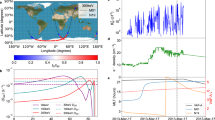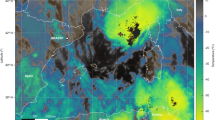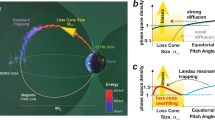Abstract
THE relatively high atmospheric pressures in the lower D region of the ionosphere, at heights below about 80 km, permit the formation of negative ions by the three-body attachment of electrons to molecules or atoms. The photodetachment of electrons from negative ions by solar radiations has been used to explain increases in electron concentrations which occur prior to ground sunrise1. Our theoretical study of the height distributions of electrons and negative ions shows the need to consider the detachment of electrons from the major negative ions throughout the day, to account for the daytime electron concentrations observed below 70 km.
This is a preview of subscription content, access via your institution
Access options
Subscribe to this journal
Receive 51 print issues and online access
$199.00 per year
only $3.90 per issue
Buy this article
- Purchase on Springer Link
- Instant access to full article PDF
Prices may be subject to local taxes which are calculated during checkout
Similar content being viewed by others
References
Moler, W. F., J. Geophys. Res., 65, 1459 (1960).
Chanin, L. M., Phelps, A. V., and Biondi, M. A., Phys. Rev. Lett., 2, 344 (1959).
Fehsenfeld, F. C., Schmeltekopf, A. L., Schiff, H. I., and Ferguson, E. E., Planet. Space Sci., 15, 373 (1967).
Fehsenfeld, F. C., and Ferguson, E. E., Planet Space Sci., 16, 701 (1968).
Fehsenfeld, F. C., Albritton, D. L., Burt, J. A., and Schiff, H. I., Canad. J. Chem., 47, 1793 (1969).
Fehsenfeld, F. C., Ferguson, E. E., and Bohme, D. K., Planet. Space Sci, 17, 1759 (1969).
Defence Atomic Support Agency Handbook (1967), DASA Information and Analysis Center, General Electric, Tempo, Santa Barbara, California.
Meira, L. G., J. Geophys. Res., 76, 202 (1971).
Shimazaki, T., and Laird, A. R., J. Geophys. Res., 75, 3221 (1970).
Narcisi, R. S., and Bailey, A. D., J. Geophys. Res., 70, 3687 (1965).
Maeda, K., J. Geoemagn. Geoelect., 23, 133 (1971).
Kamiyama, H., J. Geomagn. Geoelect., 22, 403 (1970).
Fite, W. L., and Rutherford, J. A., Discuss. Faraday Soc., 37, 192 (1964).
Narcisi, R. S., Bailey, A. D., Della Luca, L., Sherman, C., and Thomas, D. M., J. Atmos. Terr. Phys., 33, 1147 (1971).
Arnold, F., Kissel, J., Krankowsky, D., Wilder, H., and Zähringer, J., J. Atmos. Terr. Phys., 33, 1169 (1971).
Author information
Authors and Affiliations
Rights and permissions
About this article
Cite this article
THOMAS, L., GONDHALEKAR, P. & BOWMAN, M. Photodetachment of Electrons from Major Negative Ions in the Lower D Region. Nature 238, 89–90 (1972). https://doi.org/10.1038/238089a0
Received:
Issue Date:
DOI: https://doi.org/10.1038/238089a0
This article is cited by
-
Glial uptake system of GABA distinct from that of taurine in the bullfrog sympathetic ganglia
Neurochemical Research (1989)
Comments
By submitting a comment you agree to abide by our Terms and Community Guidelines. If you find something abusive or that does not comply with our terms or guidelines please flag it as inappropriate.



